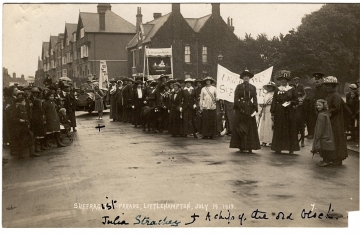What’s the story of the women’s suffrage campaign?
The full resource is FREE to all registered users of the website
If you are not already registered you can sign up for FREE website access to download the full resource.

This enquiry seeks to introduce students to a more complicated narrative of the women’s suffrage campaign than they might typically encounter in the history classroom or in popular representations. The enquiry explores how different narratives of the women’s suffrage campaign emerged and how these have evolved in light of new sources of evidence and historians’ concerns.
Key areas of focus are:
- Different interpretations of the women’s suffrage campaign, in the form of competing narratives in both academic and popular history.
- How scholarly and popular narratives of the women’s suffrage campaign have evolved over time.
- The relationship between the extant source record and the evolution of academic interpretations.
- How access to new sources of evidence (e.g. census data, local histories, oral histories) and new methodologies (e.g. mapping, big data) have opened up opportunities to ask new questions of suffrage history and changed historians’ narratives of the suffrage campaigns.
Scholarly rationale
Recent years have seen a renewed interest in the women’s suffrage campaign among historians. One notable trend within this has been to trace the history of ‘suffrage history’ (Purvis, 2010). Historians have sought to show how the ‘traditional’ narrative of the campaign was established and came to dominate both popular and scholarly interpretations of suffrage history, and how this narrative has been challenged and complicated by more recent research.
The traditional narrative of the suffrage campaign (which dominated popular and scholarly interpretations until the 1970s) includes four central claims:
- The suffrage campaign was largely moribund before the creation of the WSPU in 1903.
- The suffrage campaign was predominantly a middle-class concern.
- The charismatic Pankhursts ran the campaign as virtual dictators.
- The suffragettes’ behaviour was irrational and extreme and held up for ridicule.
The dominance of the traditional narrative was first challenged in a systematic way by the work of second-wave feminists researching and writing in the 1970s. Historians such as Jill Liddington and Jill Norris undermined the traditional narrative in two ways: first by challenging elements of the narrative (particularly the negative portrayal of the suffragettes and leadership of Christabel and Emmeline Pankhurst), and second by complicating it by seeking to uncover ‘hidden histories’, especially the contributions of working-class women. More recently, the development of technology has opened up new avenues of exploration, such as ‘big data’ statistical analysis and data mapping. For instance, one current research project by historians Tara Morton and Sarah Richardson at the University of Warwick uses sources such as 1911 census data to map suffrage activity across the UK. This research has uncovered the contributions of ordinary campaigners, including those who were involved in the suffragist campaigns.
Curricular rationale
This enquiry explores the relationship between popular and academic historical interpretations and the extant source record. Study of ‘interpretations of history’ (where an interpretation is defined as a ‘real’ subsequent account about a past that is gone) has been enshrined in the National Curriculum since its creation in 1991. Work with sources, first popularised by the SHP, is now accepted as fundamental to teaching the discipline, both at Key Stage 3 and beyond. In choosing to integrate work with sources and interpretations of history, this enquiry has been influenced by the work of those who have argued the importance of making the relationship between them explicit. For example, Husbands, writing in 1996, critiqued the assumption made by history teachers that ‘source work’ entails students working with primary sources rather than studying the ways in which others have made use of them. Ashby, writing in 2004, developed this critique by arguing that more questions should ‘address the purpose of “source-work” in schools, and its relationship to historical claims or interpretations’ (p. 53). In this enquiry, the interrelationship of the source record and subsequent historical interpretations is made the focus of students’ study. Rather than ask students to use the sources to construct their own interpretation, students are asked instead to explain both how others’ accounts have been shaped by the extant source record, and how these individuals’ interests and concerns have shaped their treatment of those sources.
